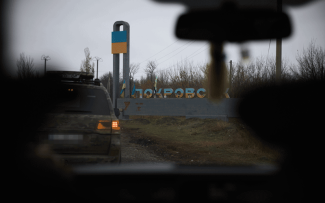Russian troops in the centre of Kupiansk. Day 1336 of the war

![]()
Ukrainian sources have confirmed that Russian forces have taken control of the centre of Kupiansk. Groups of Russian soldiers are attempting to enter its southern part. They will most likely seek to advance further south along the River Oskil in order to take control of the important Kupiansk-Vuzlovyi railway junction. The railway line running through there connects Valuyki in Russia’s Belgorod Oblast, which is an important supply point for the Russian army, with Svyatohirsk to the south and further on with Seversk, Sloviansk, Kramatorsk and Konstiantynivka. Capturing the Kupiansk-Vuzlovyi junction would not only cut off Ukrainian supply lines on the right bank of the River Oskil, but would also significantly improve the logistical and supply capabilities of the Russian forces needed for an offensive on the as yet unoccupied part of Donetsk Oblast.
Russia continues its offensive operations in the direction of Pokrovsk, which remains the main theatre of operations. Russian assault groups have managed to advance west of Novoekonomichne to the eastern suburbs of Myrnohrad and south of the Sinna Reservoir to Kozatske.
Pokrovsk is subject to persistent attempts by small sabotage groups to infiltrate the city from the south and south-west (the area along the Kotlyne – Leontovychi – Troyanda – Chunyshyne line). Their goal is to find gaps in the defence line. According to reports from Ukrainian units, several Russian soldiers managed to infiltrate the city centre, kill several civilians and occupy the railway station building, where they were then eliminated.
The enemy’s tactics indicate that the Russians clearly do not want to launch a frontal assault on Pokrovsk, as they did earlier on Bakhmut and Avdiivka, because this would result in significant losses. Instead, it is trying to cut off the last supply routes by attacking west of the city towards the Pokrovsk-Pavlohrad road and north towards Dobropillia. The attacks in the Myrnohrad area and the southern part of Pokrovsk serve as supporting actions aimed at tying up Ukraine’s forces and resources.
The commander-in-chief of the Ukrainian forces, General Oleksandr Syrskyi, stated that the Russian army’s spring-summer offensive had been effectively repelled by Ukrainian forces. Syrskyi also stated that “at the cost of enormous losses, the enemy has made only minor gains”. His statement coincided with an assessment of Russian losses by The Economist. Between January and 13 October this year, they increased by almost 60% compared to 2022–2024. Since the outbreak of full-scale war, Russian casualties are estimated to have ranged from 984,000 to 1,148,000, of which 190,000 to 480,000 were killed. The Economist also estimates that, given the pace of the offensive over the last month, it would take Russia another four years to capture the remaining areas of the Luhansk, Donetsk, Kherson and Zaporizhzhia oblasts, and as long as 103 years to occupy the entire territory of Ukraine.
![]()
The Russian army continues its air strikes on Ukraine’s energy infrastructure. On 15 October, there were combined drone and missile strikes in Dnipropetrovsk Oblast (in Pavlohrad and Kamianske), Chernihiv Oblast (including Chernihiv and Nizhyn), Sumy Oblast (including Sumy) and Kharkiv Oblast (targets included gas extraction infrastructure), resulting in power outages across large areas of Ukraine. On 16 October, energy facilities in the Poltava and Kryvyi Rih oblasts, railway depots in Chernihiv, and the Local History Museum and House of Culture in Kherson were attacked.
On 18 October, the targets of the attacks were Zaporizhzhia, Sumy, Kharkiv (one of the drones struck a student dormitory) and energy infrastructure facilities in Chernihiv Oblast (as a result, over 55,000 customers remain without electricity). On 19 October, energy infrastructure in the Chernihiv and Kherson oblasts and railway infrastructure in Sumy Oblast were attacked again.
On the night of 20–21 October, the targets of the attacks were the industrial district of Kharkiv and energy facilities in the Cherkasy, Chernihiv and Dnipropetrovsk oblasts. According to the Ukrainian Air Force Command, between 14 and 21 October, Russia used a total of 887 strike drones of various types, including 550 Shahed drones, seven X-59 guided missiles, 31 Iskander M/KN-23 ballistic missiles and two Iskander-K manoeuvrable missiles, two Kinzhal hypersonic missiles, seven S-300 missiles and nine unspecified types. 197 Russian unmanned aerial vehicles hit their targets, while air defences destroyed only 616 drones and five missiles.
Russia carried out a massive attack on a coal mine belonging to the DTEK holding company in Dnipropetrovsk Oblast. At the time, 192 mine workers were underground, but they eventually managed to get out. This was the fourth consecutive attack on DTEK facilities in the last two months.
In the early hours of 16 October, Russian ballistic missiles struck a training unit of the Ukrainian Armed Forces (UAF; most likely a training ground in Kirovohrad Oblast). According to the press service of the UAF General Staff, there were fatalities among the military personnel.
![]()
The General Staff of the UAF reported that on the night of 15–16 October, Ukrainian drones struck a Rosneft refinery in Saratov. The governor of the region confirmed the attack, but according to the Russian Ministry of Defence, all 12 drones were shot down. The Russian side did not report any damage. A day later, Ukrainian drones reportedly struck a Lukoil-owned refinery in Kstovo, Nizhny Novgorod Oblast. However, the effects of this strike have also not been confirmed.
On the night of 16–17 October, Russian forces allegedly shot down their own Su-30SM aircraft while repelling an attack by Ukrainian drones in Crimea. The drones struck a fuel depot belonging to the Atan petrol station chain in Hvardiiske near Simferopol.
On the night of 18–19 October, Ukrainian drones struck Russian oil infrastructure in the Samara and Orenburg oblasts. The General Staff of the Armed Forces of Ukraine reported that the targets of the attack were oil refineries in Novokuybyshevsk in Samara Oblast and a natural gas processing plant in Orenburg. According to Reuters, two installations in Novokuybyshevsk were shut down, and repairs may take until early November. In Orenburg, gas imports from Kazakhstan have been temporarily suspended.
![]()
On 15 October, the 31st meeting of the Ramstein format contact group of countries providing military support to Ukraine took place. Norway, Portugal, Lithuania, Estonia and Luxembourg announced that, as part of the Prioritised Ukraine Requirements List (PURL) mechanism, they would contribute €170 million, 50, 30, 12 and 15 million, respectively, while Finland and Slovenia announced their participation in the initiative without specifying the amounts.
On the same day, Denmark and Finland announced military aid packages worth DKK 1.1 billion (approximately €150 million) and €53 million, respectively.
On 14 October, the British Ministry of Defence announced that the drone coalition, led by the United Kingdom, together with Latvia, would deliver 85,000 unmanned systems in 2025, and that the UK itself had invested £600 million this year to speed up the delivery of drones to the Ukrainian armed forces.
On 20 October, Politico reported that Ukraine and the US were working on a multi-year contract under which Kyiv would purchase 25 batteries of the Patriot medium-range air defence system, financed by a €140 billion reparations loan repaid from frozen Russian assets. This type of assistance would be long-term, with the first deliveries likely to begin only two to three years after the contract is signed and continuing for at least a decade.
![]()
On 15 October, during the 31st Ramstein meeting, Defence Minister Denys Shmyhal stated that Ukraine needs at least $120 billion for defence spending by the end of 2026, and plans to obtain half of this amount from international partners. The foreign funds will be distributed among projects carried out by European arms manufacturers. Two days later, Shmyhal pointed out that over 40% of the weapons used on the front line are manufactured domestically. He estimated the potential of the Ukrainian defence industry in 2025 at approximately $35 billion, comprising around 900 companies – including around 100 state-owned and 800 private companies – and around 1,000 teams of engineers and programmers developing new military technologies.
On 20 October, a new Joint Forces Group was created within the Ukrainian Defence Forces, with General Mykhailo Drapatyi appointed as its commander. Drapatyi also serves as commander of the Joint Forces of the Armed Forces of Ukraine, responsible for all operational activities of the army. The new group’s area of responsibility covers Kharkiv Oblast and adjacent territories. This sector was entrusted to Drapatyi for the second time – in 2024, he commanded the Kharkiv operational-tactical group of forces during the active phase of the Russian offensive and its attack on Vovchansk.
General Oleksandr Tarnavskyi, who resigned in mid-June from his positions as commander of the Donetsk operational-tactical group and commander of the 9th Army Corps (allegedly for health reasons), was reappointed commander of the same corps on 20 October (the Donetsk group was disbanded as part of the reform of the Ukrainian army). Tarnavskyi replaced Major Viktor Nikoliuk, who became commander of the 20th Army Corps operating on the border between the Dnipropetrovsk and Zaporizhzhia oblasts.
![]()
According to data from Ukrainian military intelligence (HUR), between November 2024 and July 2025, more than 25,000 soldiers from the Central Military District of the Russian Federation left their units without permission. Soldiers deserted both directly on the front line and in their permanent locations. Some of them did not return to service after using up their leave or completing treatment. According to HUR, the main reasons for desertion are the harsh conditions of service, brutal treatment of soldiers and the mass deployment of troops to attacks resulting in high casualties. Ukrainian intelligence emphasises that internal reports of the Russian army cite “failure to follow orders” as the cause of death of some soldiers, which may mean that they are being shot by their own commanders.
On 16 October, the General Staff of the Armed Forces of Ukraine reported that Russian troops are engaging North Korean soldiers to conduct reconnaissance operations using unmanned aerial vehicles in Sumy Oblast. They are to be responsible for identifying the positions of Ukrainian Armed Forces units and correcting artillery fire.
![]()
On 16 October, Volodymyr Zelensky appointed Olha Reshetylova as military rights ombudsman, simultaneously dismissing her from her previous position as presidential representative for the protection of soldiers’ rights. The newly created office is to be a permanent auxiliary body to the president, ensuring civilian control over the observance of the rights of active military personnel, volunteers from territorial defence formations, reservists undergoing training, participants in the resistance movement in the occupied territories, and law enforcement officers involved in hostilities.






